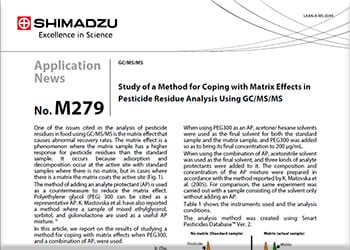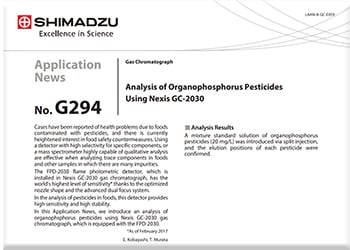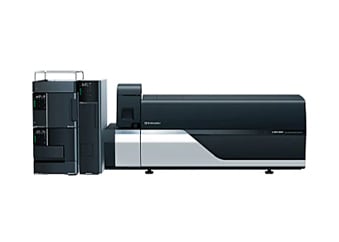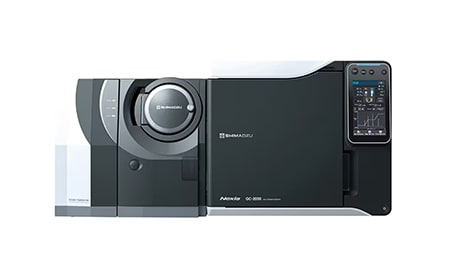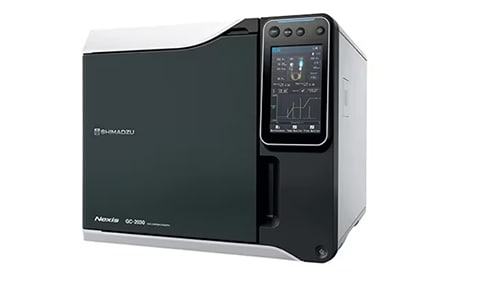The LCMS-8060NX is a triple quadrupole mass spectrometer with world-class sensitivity and detection speeds. It boasts increased robustness and ease of use as well as Analytical Intelligence to maximize your laboratory’s output.
Analysis of Pesticides
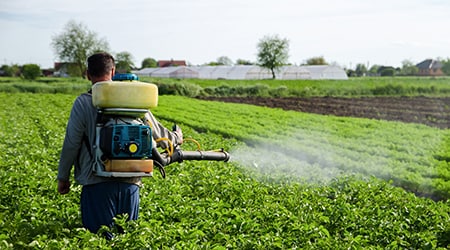
Cultivation of crops requires the use of a certain amount of pesticides in order to avoid damage due to epidemics and pests. Such pesticides are toxic, and if ingested in large amounts by humans, they carry the risk of causing dysfunction of internal organs and the development of malignant neoplasms.
Standard values are established for residual pesticides in food, and if pesticide residues exceeding the standard values are detected, distribution and sale of the food is prohibited.
Application News
LCMS
Simultaneous Determination of Pesticide Residues in Vegetable Extract by LC/MS/MS [LCMS™-8050]
To protect food safety, it is important to establish detection criteria for pesticide residues and methods to improve accuracy when measuring the concentration of the target substances. Generally, the standard addition method and matrix-matched calibration curve are more useful techniques for reducing the matrix effect than the absolute calibration method. However, these techniques are not necessarily simple, since an independent calibration curve is required for each sample of a wide variety of samples. In this report, we introduce an LC/MS/MS analysis technique which is capable of obtaining high recovery accuracy with the absolute calibration method.
GCMS
Study of a Method for Coping with Matrix Effects in Pesticide Residue Analysis Using GC/MS/MS
One of the issues cited in the analysis of pesticide residues in food using GC/MS/MS is the matrix effect that causes abnormal recovery rates. The matrix effect is a phenomenon where the matrix sample has a higher response for pesticide residues than the standard sample. It occurs because adsorption and decomposition occur at the active site with standard samples where there is no matrix, but in cases where there is a matrix the matrix coats the active site (Fig. 1). The method of adding an analyte protectant (AP) is used as a countermeasure to reduce the matrix effect. Polyethylene glycol (PEG) 300 can be cited as a representative AP. K. Mastovska et al. have also reported a method where a sample of mixed ethylglycerol, sorbitol, and gulonolactone are used as a useful AP mixture. 1) In this article, we report on the results of studying a method for coping with matrix effects when PEG300, and a combination of AP, were used.
GC
Analysis of Organophosphorus Pesticides Using Nexis GC-2030
Cases have been reported of health problems due to foods contaminated with pesticides, and there is currently heightened interest in food safety countermeasures. Using a detector with high selectivity for specific components, or a mass spectrometer highly capable of qualitative analysis are effective when analyzing trace components in foods and other samples in which there are many impurities.
The FPD-2030 flame photometric detector, which is installed in Nexis GC-2030 gas chromatograph, has the world's highest level of sensitivity* thanks to the optimized nozzle shape and the advanced dual focus system.
In the analysis of pesticides in foods, this detector provides high sensitivity and high stability.
In this Application News, we introduce an analysis of organophsphorus pesticides using Nexis GC-2030 gas chromatograph, which is equipped with the FPD-2030.
Related Products
-
-
The Shimadzu triple-quad GCMS-TQ8050 NX is capable of performing unprecedented quantitative GC-MS/MS analyses of ultra-trace amounts, down to the femtogram level. Equipped with a new, highly efficient detector and three forms of noise-reduction technologies, the GCMS-TQ8050 NX has never been more important in industries such as food safety, cannabis testing, forensics, and more.
-
The Nexis™ GC-2030 supports the analyst’s procedures beyond the laboratory, at virtually any location.



![Simultaneous Determination of Pesticide Residues in Vegetable Extract by LC/MS/MS [LCMS™-8050]](https://www.shimadzu.com/an/sites/shimadzu.com.an/files/Industry/environment/soil/c208.jpg)
